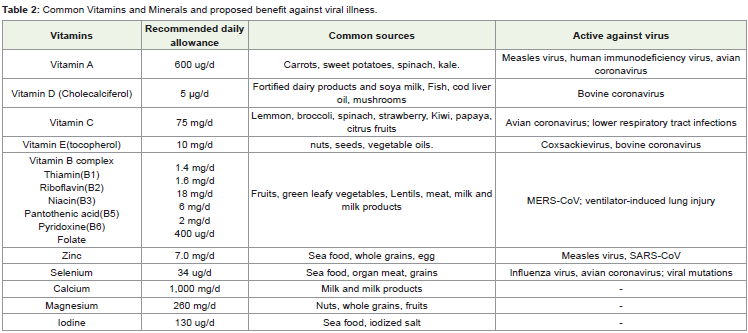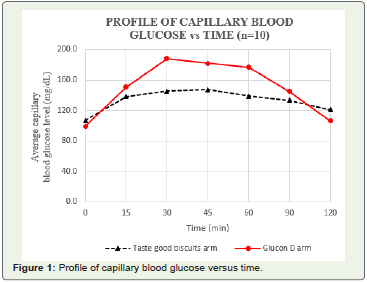Research Article
Determination of Glycemic Index and Glycemic Load of Taste Good Biscuits in Healthy Human Adult Subjects, Under Fasting Conditions
Shobha JC*, Reddy PN and Rao PV
Department of Clinical Research, Hetero Healthcare Ltd., India
*Corresponding author: Shobha JC, Head of Department (HOD), Department of Clinical Research, Hetero Healthcare Ltd., Hyderabad-500 081, Telangana, India; E-mail: Shobhaudutha@gmail.com
Article Information: Submission: 07/02/2020; Accepted: 09/03/2020; Published: 12/03/2020
Copyright: © 2020 Shobha JC, et al. This is an open access article distributed under the Creative Commons Attribution License, which permits unrestricted use, distribution, and reproduction in any medium, provided the original work is properly cited.
Abstract
Study background: Complementary alternative system of medicine is widely used in the management of Diabetes mellitus. Momordica charantia is a medicinal plant with significant hypoglycaemic activity and can be used as an adjuvant to allopathic treatment. Taste Good karela biscuits were developed with good palatability and nutritional value. It is essential to have the glycaemic index and glycaemic load of a food product, before any healthcare professional recommends it to patients with hyperglycaemia.
Objective: To determine the glycaemic index and glycaemic load of Taste Good biscuits in healthy human adult subjects under fasting conditions.
Methods: This was a single centre study. Twelve healthy human adult subjects participated, data is available for 10 subjects. The study was conducted as per the recommendations of FAO / WHO.
Results: The mean peak capillary blood glucose was 147.4±29.3mg/dL at 45 minutes with test food (Taste Good biscuits) and 188.1±29.2mg/dL at 30 minutes with reference food (Glucon D). The mean blood glucose incremental area under the curve for test food was 3681.9 min.mg/dL (SEM±736.1) and for reference food 6651.9min.mg/dL (SEM±740.2).
Conclusion: The glycaemic index of Taste Good biscuits was 57.94 which is medium as per GI classification. The glycaemic load is 6.14 per typical serving of two biscuits which is low as per the classification of glycaemic load. Taste Good biscuits can be used as a mid meal snack by patients with diabetes mellitus along with their regular anti diabetic treatment.
Keywords
Taste good biscuits; Karela; Glycaemic index; Glycaemic Load
Introduction
Momordica charantia (M. charantia), popularly known as bitter
melon, Karela, balsam pear or bitter guard and is used in the treatment
of Diabetes Mellitus (DM) [1]. Bitter guard is one of the commonly
used vegetable that contains insulin like protein known to reduce the
blood sugar levels [1]. The blood glucose lowering properties of M.
charantia have been consistently demonstrated in clinical trials [2].
A number of bioactive phytochemical compounds have been isolated
from it [2].
M. charantia has a good nutritional value containing a variety of
phytonutrients like dietary fibre, minerals, vitamins and antioxidants
[1,3]. Possible modes of hypoglycaemic actions of M. charantia are
due to phytonutrient Polypeptide - p or p-insulin. This plant insulin,
works similar to human insulin in the body and lowers the blood
glucose levels apart from protecting the pancreatic islet cells [1].
The other bioactive phytochemical compound is Charantin. This
helps in promoting insulin release and stimulates the peripheral and
skeletal muscle glucose utilisation. Inhibition of intestinal glucose
uptake and its transportation, suppression of key gluconeogenic
enzymes are some of the other actions of charantin [1].
In addition to the glycaemic control, M. Charantia is proposed
to have protective effects on target organs by delaying nephropathy, neuropathy, retinopathy, gastroparesis, cataract and atherosclerosis as well [2].
The concept of food as medicine is the central theme in diabetic
and nutritional science [1]. Natural food products are acquiring
substantial importance for the treatment of diabetes mellitus [4]. M. charantia has been used as a dietary supplement and ethno-medicine
throughout centuries for relieving symptoms and conditions related
to diabetes mellitus [1]. Food quality and diabetes mellitus have close
association with each other.
With this concept of food, as medicine Karela Biscuits (TASTE
GOOD) were developed by AZISTA INDUSTRIES PRIVATE
LIMITED, HYDERABAD as a mid-meal snack (between two meals).
These biscuits are high in fibre, with no added sugars, zero trans-fat
and no cholesterol [5].
Glycaemic Index (GI) is a scale which helps in ranking the carbohydrate containing foods, depending on how rapidly, the blood glucose levels raise in a span of 2 hours after having the food/food product as compared to pure glucose, which is assigned a glycaemic index value of 100 [5].
Glycaemic load is also a better predictor of glycaemic response [6]. It indicates whether the food eaten in typical servings is healthy or not.
It is important to establish the GI value of the Taste Good biscuits and make it available to the population. Hence, the present study was undertaken to determine the glycaemic index and glycaemic load of Taste Good Biscuits in healthy human adult subjects under fasting conditions.
Materials and Methods
This study was approved by the Institutional Ethics Committee,
Ramdev Rao Hospital, Hyderabad. 12 healthy, non-diabetic, adult
subjects of either gender, aged between 18 - 45 years were included
in the study. Written informed consent was obtained from the
participants before initiation of the study related procedures.
On the day of study, subjects reported in the department after
an overnight fast of 10-12 hours [7]. A general clinical examination,
anthropometric measurements were recorded. Subjects received
either Taste Good biscuits or Glucon D as per randomization. After
a washout period of 3 days, during the period 2, those subjects who
consumed Taste Good biscuits during the period 1 received and
consumed Glucon D and vice versa ( the subjects were crossed over
during the period 2).
Each subject consumed either 95 grams of Taste Good biscuits
(equivalent to 50 grams of glucose) with 250 - 500ml of water or
50 grams of Glucon D dissolved in 240ml of water. The study food
products were consumed within 12-15 minutes. The subjects were
restricted from performing any physical activity during the 2 hour
study period.
Baseline fasting capillary blood sample was collected by finger
prick method. Blood glucose levels were estimated using glucometer
(Accu Chek Roche Diabetic Care, calibrated with the control solution)
[8]. Further capillary blood samples were collected at 15, 30, 45, 60, 90 and 120 min after completing the consumption of the study food
products [7,9].
Blood glucose curves were constructed from capillary blood
glucose values for each subject at time 0, 15, 30, 45, 60, 90 and 120
minutes intervals after consumption of the study food products. The
average blood glucose response curve was constructed by the mean
blood glucose concentration of the subjects at each time point.
Blood glucose concentration was calculated by subtracting the
fasting value. The incremental area under the blood glucose response
curves (IAUC) was calculated by applying trapezoidal rule for each
subject separately [10].
Glycemic index (GI) for each individual subject was calculated by
Test IAUC by the Reference IAUC .
Resulting mean value of the 10 subjects was the GI of the test food
product (Taste Good biscuits).
The glycemic load (GL) is the impact of the carbohydrate
containing food has on blood sugar. GL = GI (%) x grams of
carbohydrate in the typical serving of test food eaten.
Results
Out of 12 subjects enrolled, two were lost to follow up and were
eliminated from analysis. Demographic data is available for 10
subjects. Out of 10 subjects 3 were males and 7 were females, the mean
age was 29.2±4.7 yrs, mean height, weight and BMI was 160.7±7.3
cms, 71.0±17.3Kgs and 27.3±5.3 respectively (Table 1).
Table 2 shows the capillary blood glucose response from 0 min to
120 min with Test food product (Taste Good Biscuits) and reference
food product (Glucon-D). The mean fasting capillary blood glucose
was 106.9±17.5mg/dL with the test food product and 99.2±9.9mg/
dL with the reference food product before consumption of the study
food products. The mean peak capillary blood glucose was 147.4±29.3 mg/dL at 45 min with the test food and 188.1±29.2mg/dL at 30 min
with the reference food.
Mean capillary blood glucose response with test and reference
food products (mg/dL) are shown in Figure 1.
The mean blood glucose incremental area under the curve for
test food was 3681.9min.mg/dL (SEM±736.1) and for reference food
was 6651.9 min.mg/dL (SEM±740.2). The Glycaemic index of the test
food product was 57.94.
The Glycemic Load was calculated as the GI (%) multiplied by
the grams of carbohydrate in typical serving of the test food (2 Taste
Good biscuits).
♦ Each 10 gram Taste Good Biscuit contains 5.3 grams of carbohydrates.
♦ Typical serving = 2 Taste Good Biscuits.
The study food products were tolerated without any untoward
effects.
Discussion
One of the modalities of treating hyperglycaemia naturally and
economically is through diet. Quality of food is closely associated
with diabetes mellitus and proper diet can reduce its incidence and
severity. Eating foods with high GI can be detrimental to health
because it raises the blood glucose levels. Switching to eating foods
with low or medium GI has many benefits.
It is suggested that along with regular meals a small snack between
meals helps patients on anti-diabetic treatment. Improving the
acceptance by modifying the bitter taste and formulating palatable
foods with optimal nutritional and medicinal values was the objective
of developing Taste Good biscuits with bitter gourd [3].
Presence of inhibitors in bitter gourd showed hypoglycaemic
action in diabetes. Consumption of 40gm of bitter gourd for 30days
lowered post-prandial glucose by 36% in diabetes [5].
The glycemic index of Taste Good biscuits was medium (57.94)
as compared to baked recipes like maize dhokla with dal (116.3) and
steamed and wheat bati with dhal was 112.6 [5].
Foods with low or medium GI can increase the sensitivity to
insulin and improve the diabetes control by reducing the hunger and
keeping full for a longer duration of time. Starch not only reduces
postprandial glycaemia but also exerts sustained effect on satiety [12].
The success of diets containing low or medium GI and their
clinical utility in controlling hyperglycaemia needs to be established.
As the International Diabetes Federation guidelines recommends that
postprandial hyperglycaemia is harmful and should be lowered by
incorporating a variety of non-pharmacological and pharmacological
therapies [13].
It was essential to determine the glycaemic index and glycaemic
load of Taste Good biscuits, before Health Care Professionals
recommend it to patients with diabetes as mid meal snack.
Our future plan is to evaluate whether addition of Taste Good
biscuits to existing anti diabetic therapy results in better glycaemic control and is able to reduce the glucose variability by using
continuous glucose monitoring in patients with diabetes mellitus.
Conclusion
Excellent taste with medium glycaemic index and low glycaemic
load of the typical serving of two biscuits was achieved with Taste
Good biscuits with added medicinal benefits of karela for patients
with diabetes mellitus. The findings of the present study will be of
great help to healthcare professionals while treating patients with
hyperglycaemia.







